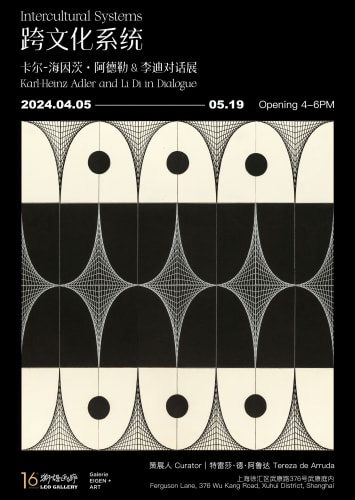Leo Gallery | Shanghai
Intercultural Systems: Karl-Heinz Adler and Li Di in Dialoge
The exhibition Intercultural Systems: Karl-Heinz Adler and Li Di in Dialogue conceived for Leo Gallery and curated by the art historian Tereza de Arruda presents a selection of works by both artists, who are for the first time presented in a common context. This exhibition is in partnership with Galerie EIGEN+ART.
Karl-Heinz Adler (1927 Remtengrün - 2018 Dresden/Germany) and Li Di (1963 North China) are two artists from different cultural backgrounds and artistic traditions, but their work and lives intersect in interesting ways. They were born and educated as artists in two countries with strong socio-political-cultural relationship. Overall, the relationship between the DDR and China in cultural aspects reflected the broader geopolitical dynamics of their era, characterized by solidarity among socialist countries. Cultural exchanges served as a means of promoting mutual understanding and cooperation between the two nations. Both painters started their artistic education under a similar premises. The aesthetic in the painting of the German Democratic Republic (DDR) and China during the mid to late 20th century was shaped by distinct local contexts, resulting in unique visual styles reflective of the respective societies: largely figurative and representational, with an emphasis on clear, straightforward imagery that could easily convey visual messages to the viewers. Realistic portrayals of social representants, and landscapes were common, often rendered in a style reminiscent of 19th-century academic painting.
After finishing a similar traditional study, both artists who never met each other personally, developed comparable own artistic language and career. Karl-Heinz Adler dedicated himself to the abstract art associated with the Concrete Art movement, known for his geometric compositions and exploration of form, color, dynamic, optical effect and space in compositions emphasizing mathematical precision and formal experimentation. Li Di focused himself also to the representation of geometry, abstraction, and the relationship between form and the space evoking a sense of spirituality and harmony through the repetition of simple gestures. For both artists transitioning from Socialist Realism to Concrete Abstract Art represented a shift towards exploration of the formal elements of art using abstraction as a means of conveying complex ideas and sensations that transcend literal interpretation and representation. By restricting the range of colors - usually black and white followed by their nuances - as usual in abstract concrete art, both artists direct the viewer's attention to the geometric shapes, lines, and composition of the artwork. Without the distraction of a wide array of colors, the viewer is more likely to engage with the structural elements and spatial relationships within the piece.
Li Di moved at the end of the 80`ies to Germany to study with Walter Dahn, at the Hochschule für Bildende Künste in Braunschweig. Since 2010 he has lived between Braunschweig and Beijing, teaching at Ningbo University and having the chance to experience not just the reunification of Germany and its consequences, but also the cultural and artistic issues of German Contemporary Art. The exhibition Intercultural Systems - Karl-Heinz Adler and Li Di in Dialogue is an important milestone not just to review the oeuvre of both artists presented side by side for the first time but also as an unique opportunity to intensify the transcultural dialogue presenting works by Karl-Heinz Adler for the first time in China.
The curatorial research and selection of the works was guided by the visual impact of the artistic compositions developed in a non-linear path, but full of commitment and self-investigation due to the desire of both artists to expand their potential beyond their original universes and backgrounds. The focus here is on dialogues made up of different perspectives in a variety of paintings on canvas and paper, assemblages on wood and photographs. These images represent the realisation of art in public spaces through the facades of buildings in the former DDR designed by Karl-Heinz Adler and Friedrich Kracht. Moulded concrete block system punctuated the urban panorama on a monumental scale. They became enduring symbols of historical significance, cultural heritage, and architectural intervention composing the collective memory and now expanding its significance in this unique dialogue in Shanghai – a modern city composed of tradition, embodies a unique juxtaposition of historical heritage and contemporary innovation.

